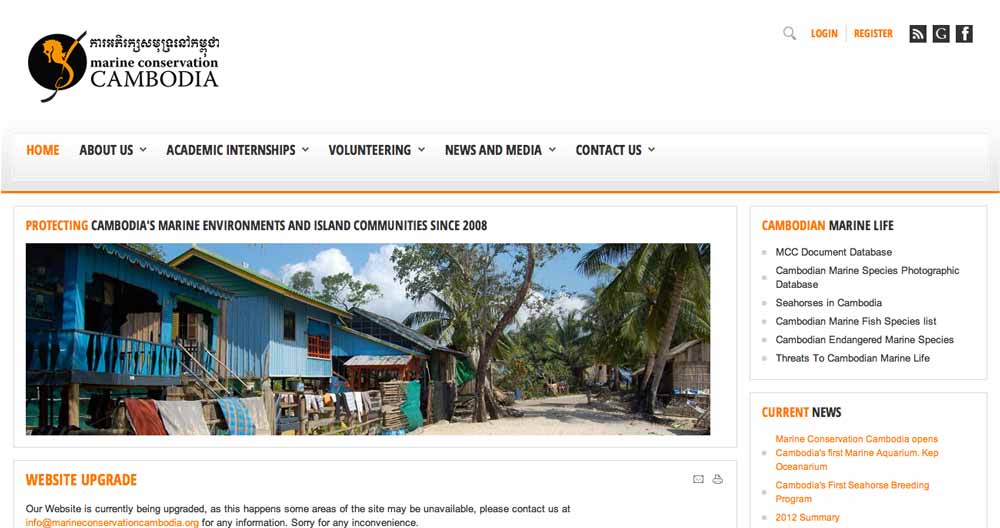
We decided when updating our website to leave the original one intact and let you see where we came from and how we have developed.


We decided when updating our website to leave the original one intact and let you see where we came from and how we have developed.
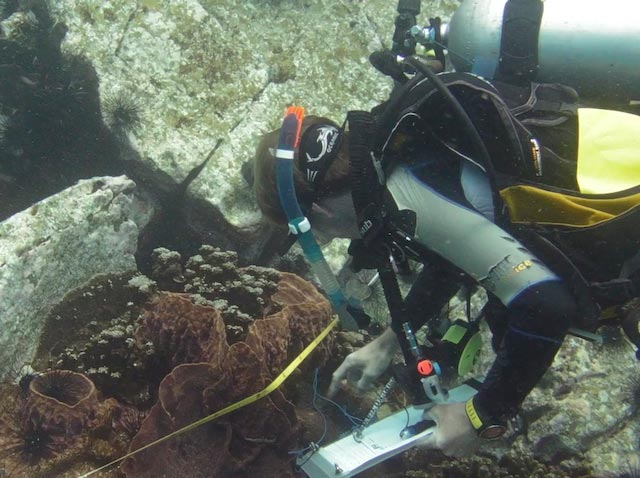
 Conservation is foremost about protection but with that comes the need for research. Here in Cambodia we can see clearly that need for conservation every time we go diving, there is a desperate need for direct action and protection of the marine environment.
Conservation is foremost about protection but with that comes the need for research. Here in Cambodia we can see clearly that need for conservation every time we go diving, there is a desperate need for direct action and protection of the marine environment.
We also witness this need when we see endangered species for sale in local markets, when we hear dynamite explosions whilst diving, when we see illegal trawling within the delicate habitats of the inshore areas, and when we see the use of cyanide and other destructive fishing techniques on our local reefs and ecosystems. These are all events that bring immediate attention to the need for immediate action.
An example of how our research is used to complement the conservation efforts is in the creation of the new Marine Fisheries Management Area around Koh Rong and Koh Rong Samloem, our socio-demographic survey reports and marine survey reports were used to highlight the most bio-diverse areas and those in need of protection, to be used in the MPA planning process and creation of zoning management maps. With that MPA in place we were invited to do it all over again in another even more sensitive marine environment, the marine habitats of seagrass and coral reef within the south eastern coastal province of Kep. This work is now underway and the beginnings of a new marine fisheries management area and marine protected area are underway. You can read the initial marine assessment reports and summary recommendation reports here.
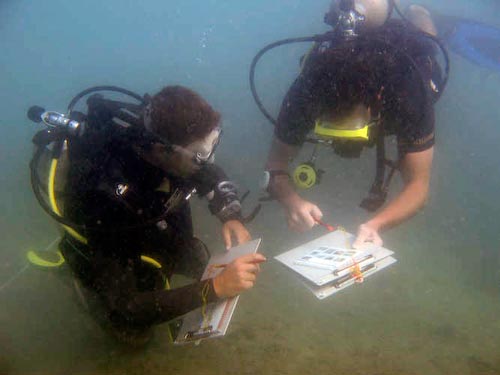 The need for immediate Pro-active conservation must be coupled with the collection of solid data to prove beyond doubt which actions have are having a detrimental effect on the local ecosystems and also to prove the benefits of any conservation programs. When witnessing first hand the large amount of damage that can be done in a very short time it is easy to understand the need for protection but for anyone not directly witnessing the destruction a need for clear data is essential. When we take action towards marine conservation we need to assess whether an area needs protection, why it needs protection and what it needs protection from. These are just a few of the major questions we need to ask. We need to look at all factors from the obvious to the not so obvious.
The need for immediate Pro-active conservation must be coupled with the collection of solid data to prove beyond doubt which actions have are having a detrimental effect on the local ecosystems and also to prove the benefits of any conservation programs. When witnessing first hand the large amount of damage that can be done in a very short time it is easy to understand the need for protection but for anyone not directly witnessing the destruction a need for clear data is essential. When we take action towards marine conservation we need to assess whether an area needs protection, why it needs protection and what it needs protection from. These are just a few of the major questions we need to ask. We need to look at all factors from the obvious to the not so obvious.
Critical thinking is required and science is needed. By investigating marine ecosystems to quantify the biodiversity and abundance of flora and fauna then measure the impact of external activities we can start to draw conclusions about the negative and positive effects each action has on our local marine ecosystems.
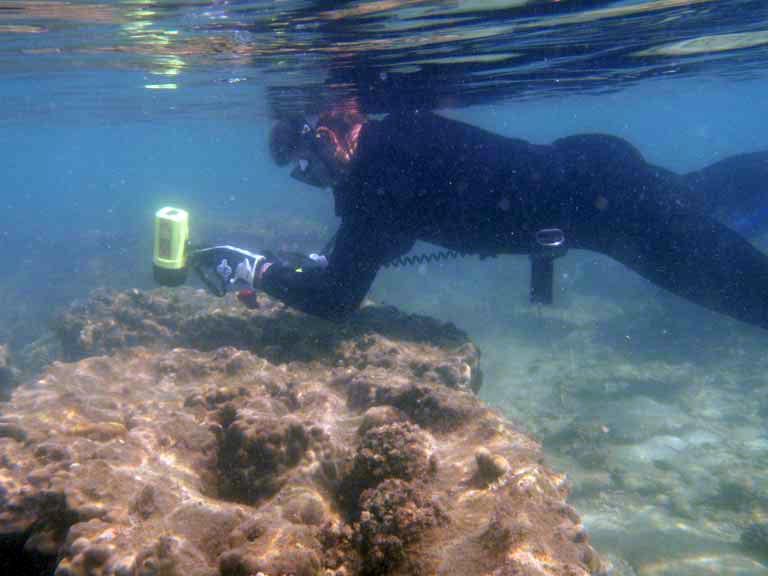 Through a scientific monitoring program our team of scientific researchers and trained research divers investigate the marine environmental conditions within specific areas, this information has and is being used to assist the local and national government in their strategy planning for marine conservation and integrated coastal management. As part of our team you will be involved in marine conservation and marine research, this means that during your time with us you will be trained in a number of marine survey methodologies and identification techniques that will allow you to monitor our target sites. Besides learning the methodology of collecting data, you will also learn how to enter and analyse that data. The identification training will allow you to learn about which species live in Cambodian coastal ecosystems and how to recognize them.
Through a scientific monitoring program our team of scientific researchers and trained research divers investigate the marine environmental conditions within specific areas, this information has and is being used to assist the local and national government in their strategy planning for marine conservation and integrated coastal management. As part of our team you will be involved in marine conservation and marine research, this means that during your time with us you will be trained in a number of marine survey methodologies and identification techniques that will allow you to monitor our target sites. Besides learning the methodology of collecting data, you will also learn how to enter and analyse that data. The identification training will allow you to learn about which species live in Cambodian coastal ecosystems and how to recognize them.
For those that develop a passion and want to learn more about marine research further training can be given to take you up to the level of team leader.
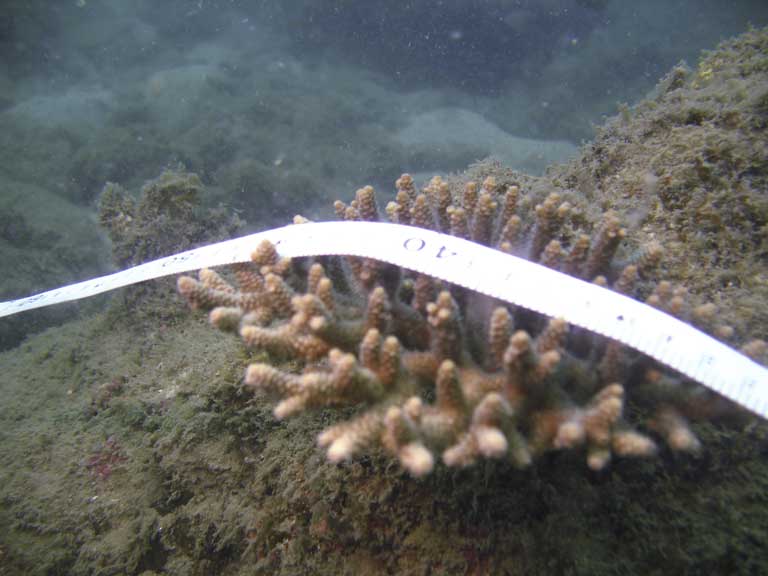 Once trained you will join together with other volunteers, interns and specialists and spend time in the field, conducting marine surveys using the scientific techniques you have learnt in order to collect, collate and analyse data on the marine environment. Investigative projects include seahorses surveys, Benthic Surveys, biodiversity and abundance surveys to name a few.
Once trained you will join together with other volunteers, interns and specialists and spend time in the field, conducting marine surveys using the scientific techniques you have learnt in order to collect, collate and analyse data on the marine environment. Investigative projects include seahorses surveys, Benthic Surveys, biodiversity and abundance surveys to name a few.
This information once analysed and written up into report form is then submitted to the Cambodian Fisheries Administration and the local Provincial Government, in turn this assists the Royal government of Cambodia in managing and maintaining a sustainable marine environment for future generations.
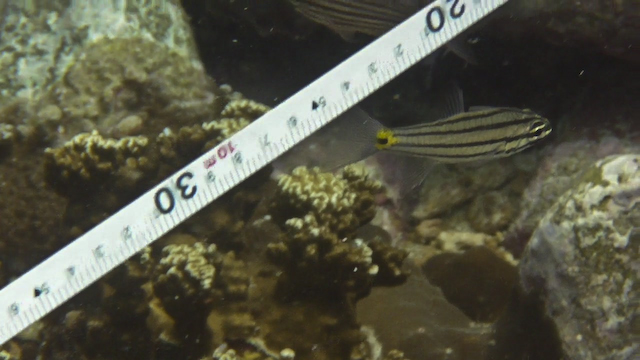 Our Team is among the few to be out there all the time, doing research and keeping the destruction at bay. We are conducting extensive surveys throughout the coast of Cambodia. In our first 2 years of operation we recorded data from over 1000 different sites and now after 8 years of operation we have extensive experience covering Cambodian marine habitats, ecosystems and marine life, from community socio-demographics to quarterly and yearly reports on marine reef heath, seahorse diversity, abundance and seagrass monitoring we pretty much do it all.
Our Team is among the few to be out there all the time, doing research and keeping the destruction at bay. We are conducting extensive surveys throughout the coast of Cambodia. In our first 2 years of operation we recorded data from over 1000 different sites and now after 8 years of operation we have extensive experience covering Cambodian marine habitats, ecosystems and marine life, from community socio-demographics to quarterly and yearly reports on marine reef heath, seahorse diversity, abundance and seagrass monitoring we pretty much do it all.
Many of these sites had never been researched or reported on before. We are pushing the boundaries of the known territories in underwater Cambodia! Now we are breaking new ground again after being invited to study a whole new undived and unexplored province.
{modules [329]}
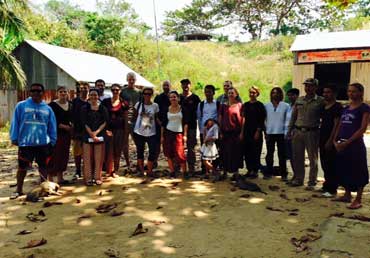
 Welcome to the world of Marine Conservation Cambodia. As you have probably already read we are a small grass roots conservation group based in Kep Province, Cambodia. We are situated on our own private island, Koh Seh is roughly 18km from the mainland town of Kep. Kep Mainland itself is an area rich with history dating back to when Cambodia first developed as a country. With beautiful national parks and a diverse culture.
Welcome to the world of Marine Conservation Cambodia. As you have probably already read we are a small grass roots conservation group based in Kep Province, Cambodia. We are situated on our own private island, Koh Seh is roughly 18km from the mainland town of Kep. Kep Mainland itself is an area rich with history dating back to when Cambodia first developed as a country. With beautiful national parks and a diverse culture.
Almost on the border of Vietnam, our tropical paradise island of Koh Seh offers a sanctuary that can’t be matched. With sweeping views of our neighboring 6 islands, there is no place on Koh Seh the view is simply not spectacular. Our beautiful bay offers calm seas almost all year round, whilst the rest of the island is covered in dense Jungle. Koh Seh is an outcrop island, meaning it is essentially a small mountain that slopes to the warm tropical waters. The warm winds make it an ideal place to watch a sunrise, or climb over the hill for a breathtaking sunset.
Diving into our protected waters you can witness first hand the stunning diversity that is slowly coming back to our area. After the last two years of protection we are seeing an explosion of previously absent species. Regular visits from the Dolphins and the occasional Turtle are always a bonus. And even though we have not seen them yet we are also on the main migratory route for Dugongs too!!. Our work on the conservation of our area is something that any long staying volunteer can see direct results from during their time on the island.
Living on the island you will truly get to learn and love Cambodian culture. From eating local Khmer food to getting to know our local team members. It is a warm and welcoming culture, one which you will begin to love and will always remember.
If you are tired of witnessing the destruction of the world’s oceans, but don’t know how you can make a difference? Thinking about volunteering, but don’t know which organization to trust? Want to take direct, hands on, action that will have an immediate result? You have found us, that is what we do daily and we need your help and support.
 At MCC we are always looking for those dedicated volunteers and interns who truly want to make a difference. If you are looking for a beachside vacation with the odd dive here or there, MCC probably isn’t the place for you. We do NOT offer voluntourism, we do not try to sell you something we think you want, we integrate you into our team and continue the work we have been entrusted to carry out involving you and utilising your skills and passion, our goal is conservation and the regeneration of a once beautiful area that is in the beginnings of recovery.
At MCC we are always looking for those dedicated volunteers and interns who truly want to make a difference. If you are looking for a beachside vacation with the odd dive here or there, MCC probably isn’t the place for you. We do NOT offer voluntourism, we do not try to sell you something we think you want, we integrate you into our team and continue the work we have been entrusted to carry out involving you and utilising your skills and passion, our goal is conservation and the regeneration of a once beautiful area that is in the beginnings of recovery.
With 10 years of operational experience in Cambodia and a professional team of experienced, Marine biologists, Marine ecologists and environmental scientists Marine Conservation Cambodia welcomes both volunteers and international research assistants looking to gain practical conservation and research experience in the field, you can get involved our ongoing Marine research programs, community development projects and obtain on the ground skills in marine conservation and marine research along with your scuba diving qualifications, at the same time experience living life on a beautiful rural Cambodian island. We really do need your help and you can really make a difference using our established conservation network. Many of our past interns and volunteers have either continued on to successfully complete their education or moved directly on into full time marine research or conservation work using the practical experience they gained with us.
While at Marine Conservation Cambodia our volunteers will learn multiple survey techniques as well as other types of marine conservation practices. We currently teach our volunteers surveying techniques and general knowledge in 10 crucial areas. You can see a selection of our current research projects here:
The data collected from surveys is used to help assess the current status of our MFMA (Marine Fisheries Management Area), plan and develop new strategies and identify key habitats, as well as educating the communities on what is happening in their waters. You can download our current Kep marine assessments here.
Not a certified SCUBA diver? Not a problem. We have a qualified dive instructor at MCC who would be more then happy to train and certify you. Want to become a dive master or simply upgrade your current dive level our staff can accommodate that as well. Having the ability to dive as often as you want makes getting those certification dives much easier not to mention much cheaper.
So if you are a non-diver, our experienced PADI/SSI instructors can train you up to PADI or SSI Advanced open Water Level within the first two weeks of your stay, after which you will be ready for training in underwater marine survey techniques so you can start collecting data as a marine researcher. You will not only gain personal skills and experience, but the data you collect go’s directly toward the development and maintenance of Kep’s First Marine Protected Area. Further diving training is available on request, and many of our interns move on to higher level dive leader courses.
Diving Qualifications and skills you can gain include:
Diving isn’t the only type of marine conservation we do at MCC. Weekly we head into the local fishing communities to collect data from actual local fishermen. This data is collected in our socio demographic surveys and helps get the locals view on the current status of Cambodian waters. Beyond an interview it is also a great way to meet locals and experience their culture.
Is data collection simply not enough for you? Do you want your efforts at MCC to have a direct, immediate result? We are one of the very few volunteer organizations who can accommodate these wishes. As a member of the MCC team you may have the opportunity to join us patrolling within the MFMA. This is completely optional of course, but for those who have an adventurous side, it’s the ultimate conservation rush.
When the diving is done for the day the activities continue. From beach cleanups to recycling the garbage that washed up on our shores we try to practice as much conservation out of the water as we do in the water. We are currently developing a new type of composting technique as well as designing a battery powered by saltwater. All volunteers and interns are strongly encouraged to bring their conservation ideas to the island.
As we are a small grassroots conservation organization we tend to be much more relaxed compared to the larger worldwide charities. If you don’t feel like doing an activity or simply need a break from diving you are welcome to it. Explore the island and discover the hidden secrets of Koh Seh. From the different types of fruit trees to the war bunkers left over from Cambodia’s turbulent past, there is always something to do while at MCC.
The weekends are down time at MCC allowing the entire team to catch up on some much needed rest. You are welcome to stay on the island, filling your time however you want, or return to the mainland and explore the costal area of Cambodia. The Island on the weekend is extremely relaxing. From movie marathons to fun dives, it is your time, so do what you want. In town you can hike in the national parks or simply site poolside to work on your tan. Your activities are only limited by your imagination in Southern Cambodia.
Volunteering or being an intern with Marine Conservation Cambodia is truly a life altering experience. Many of our previous volunteers and interns have extended their trips or wished they had. Often we get volunteers and interns returning year after year. Many of the reasons they extend or return has to do with the conservation aspect of MCC, but another large part is the community like feel of life on the island. The friends you make at MCC will be friends for life!
Want to get involved and join our team? Simply fill out the form, to get the process started. Have questions you want answered? Just send us an email and we will respond. Thank you for taking an interest in Marine Conservation Cambodia. We truly look forward to hearing from you.
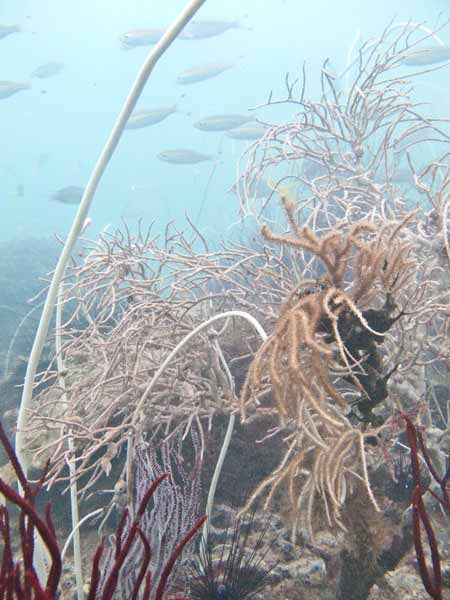
 Conservation : Noun
Conservation : Noun
The protection of natural resourses
To Conserve :Verb
To prevent something from being wasted, damaged, or destroyed
To Protect : Verb
To prevent something from being harmed or damaged
Throughout the world costal regions have played one of the most significant roles in the development of a country. In many cases the largest cities of a country were started where the sea ended and land began. The wealth of resources costal regions can offer in the development of a country almost can’t be measured. From being a source of renewable food, to opening the country up to the rest of the world via trade routes for supplies, waterways have been a critical environment to the success of endless countries. In many ways this applies to Cambodia as well.
The largest major cities in Cambodia are located far inland from the sea, but in no way does this discount how crucial Cambodian waters are to the country. With rich marine habitats, diverse marine species, and bountiful marine resources, Cambodia costal regions have played a key role in this countries development throughout its history up to where it is today. Since the beginning of Cambodia’s history their coastlines have be a food source for the entire country, a livelihood for local fishing communities, and played a critical role in Cambodia’s defenses during times of war.
With such an importance being placed on one single resource, as that country grows, so does the destruction of that resource. Cambodia is not exempt from this destruction, and in many ways, it is in a more critical state then a majority of other countries.
Cambodia has had a very difficult and often sad history. For many years this country was in various states of war and even suffered through a horrendous period of civil genocide. Overcoming these times forced the governments of Cambodia to make choices many other countries have never had to face. With almost no industry in Cambodia and the pressing need to save the Cambodian people, the country looked to its natural resources as a way to help the country.
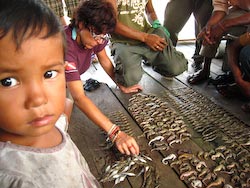
Every other country in the world uses their natural resources to drive its economy and Cambodia is no different. Unlike other countries Cambodia was coming out of horrific times and when it looked to the rest of the world for help, many countries turned their back on Cambodia. Being forced to take on this daunting task alone very few resources we taken with sustainability being considered or with any form of protection placed on them. Even today Cambodian ministries simply do not have the funding to prevent destruction of its natural resources and their waters are in serious jeopardy.
As Cambodia becomes a modern country these resources, especially their oceans, are being put on under heavy strain. Increased tourism, increased export of multiple sea products, and the uncontrolled development of costal regions are over-taxing this resource.
To meet the demands fishermen are being forced to take drastic measures. Illegal and destructive fishing practices have almost become the normal way of life in costal fishing communities just to keep these communities competitive.
As many countries surrounding Cambodia have already fished out their waters we are seeing a large influx of foreign illegal fishing 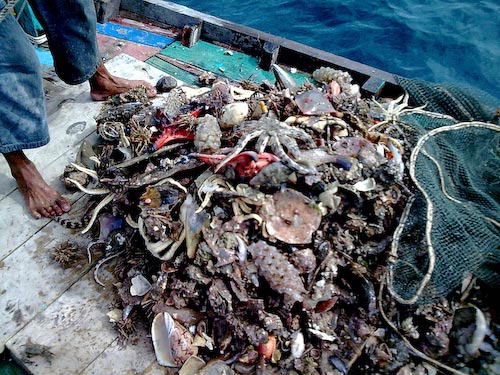 vessels entering Cambodian waters practicing the same destructive fishing practices as Cambodian fishing vessels. With the damage caused by foreign vessels added to what is being done by local fishing communities it is not unrealistic to imagine Cambodian waters being pushed to the point of permanent collapse.
vessels entering Cambodian waters practicing the same destructive fishing practices as Cambodian fishing vessels. With the damage caused by foreign vessels added to what is being done by local fishing communities it is not unrealistic to imagine Cambodian waters being pushed to the point of permanent collapse.
Without immediate and serious intervention the collapse of this resource is inventible. The Cambodian Government simply does not have the resources to fund, monitor, or enforce what is going on in their waters, which is one of the major reasons Marine Conservation Cambodia is here.
A wonderful speech was given in Scotland by Amanda Vincent, one of the worlds foremost seahorse experts. Amanda Vincent highlighted this same need for immediate action in protecting our marine environments. She emphasised how the scientific community shouldn’t use a ‘lack of data’ as an excuse for being over cautious and taking no action. She used a clever medical analogy to drive home her point…when treating patients doctors use all available evidence to treat the condition most effectively, but in cases or conditions where knowledge is lacking they don’t just stand by and do nothing. They use what knowledge they have, however little that might be, to make the best possible decision, because some action (even if there is the threat of it not being totally correct) is often better than taking no action at all. Sometimes conservation NGO’s have a tendency to become a little detached from the real world, getting ‘papers published’ but neglecting the activism that is so essential if we are to make changes.
This article is adapted from our first end of year summary written after our first full year of operation, it was a crazy time, No tourism, No Support, No Finances.
Just us the village, poverty and crazy fishermen with guns and dynamite.
Marine Conservation Cambodia in its first 12 months went from strength to strength, mainly down to the dedication and commitment of the Marine Conservation Cambodia team and the volunteers that had given their time, energy and passion to help protect Cambodia’s marine environment and the crazy driven passion of its founder Paul Ferber. With times of no food, no water and being reduced to eating the same fish bones soup after three days of boiling for breakfast lunch and dinner, just give me some jungle leaves anything to make it taste like food.
Our achievements over that first year started to change the tide of destruction that was rapidly destroying some of the most unique habitats in SE Asia areas we loved areas we dived daily and could see the destruction first hand. The protection of the Corral a dive site we named in 2007 and one of the main Seahorse breeding grounds we had discovered, the creation of the largest community managed marine area in Cambodia which took almost two years to see happen allowed us an opportunity for hope that some of the diverse marine habitats we had discovered would be able to begin recovery.
The surveys we conducted, which lets be honest were not the most scientific but hey we were learning and it was a little to crazy out there and we were a little to new to be able to find anyone with real skills, but as passionate divers we identified many new areas to be legislated for protection and increased the overall knowledge and documentation on Cambodian marine species, including the discovery of one new unknown species of Nudibranch not to mention putting Cambodia firmly on the map as a seahorse paradise. During that first year we argued a lot with so called knowledgeable foreigners who being to scared to actually do anything cried research, research, research, yet did nothing constructive except trying to find funding for themselves to stay in Cambodia and live the NGO lifestyle (we can come back to this in a later summary :).
Our Seahorse project brought national and international attention to Cambodia’s diverse but declining Seahorse populations, leading to the creation of governmental sub decrees that now make it illegal by Cambodian law to catch or trade in Seahorses. This was a time to celebrate, as this became law we celebrated the protection of the seahorses, but in our naivety we forgot to take into account that you need enforcement or laws mean nothing, did not take us long for our short lived celebrations to return to the oh shit we just lost another area to the trawlers and back to that creeping feeling of uselessness, again hitting home that this fight was not about paper and money, it was about true grit, determination and a general disregard for our own personal safety not to mention a lot of drowning our sorrows with rice wine and old school Khmer dancing.
The close working relationship we developed with the Cambodian Ministry of Fisheries still continues today and has also turned into many lasting friendships, this at the time lead to the creation of a 4km buffer zone around the islands of Koh Rong and Koh Rong Samloem. This zone was created to protect the diverse inshore areas around both islands from the sand extraction vessels, which were operating in Cambodian waters. One small boat, 5 or 6 crazy people. Night time special opps or oops as your head hit the bottom of the large steal hull in the dark, filming the boat at night that used the excuse oh sorry our anchors broken we had to use our large pipe to anchor the boat, over this very large hole that was not there before, uuuummmm! But hey the video was great and well received on delivery to the right people, job well done.
The changes were not only at national level but also provincial level and within the local community level, with volunteers running daily lessons at the Koh Rong Samloem school, the creation of a referral clinic for the Koh Rong Samloem community and the extra income generated through true eco-tourism helped the local island economy creating jobs and small community run businesses that catered for the volunteers.
All together it was an amazingly successful year, didn’t know what we were doing, but did it anyway, risked life and limb to save the little horses, why? Just because they were peaceful. Became very accustomed to rice in all its forms including liquid, never though rice could give you such a headache in the morning.
There was a big thank you to all those who were involved and a warm welcome to those that would come to join us in the future. We learnt a lot about bureaucracy, angry men with guns, crazy kids with machine guns, and how to function in a village that was never sober and often did not allow you to be either.
At this point before we finish we must not forget Sao, who build a kitchen from cardboard boxes, set fires around the camp to keep out snakes and other unpleasant creatures and generally made everyone feel like mum was looking after them.
If you are interested in getting involved or supporting the project now its more organized, not so dangerous and definitely more scientific please contact us for more details
Please take a look through some of the areas that are available, to see current or previous reports by MCC researchers, interns and volunteers on the subjects below please follow the links to the relevant downloadable document.
Marine Ecology/Biology
Integrated Coastal Management, Including Fisheries Management and Socio-Economic Research
Sustainable Development
Marine Conservation Management
Terrestrial Ecology/Biology
By special request, Prepare and inventory of terrestrial species both flora and fauna and their ecology within the 13 islands of Kep province. (We have already found 1 new species of orchid)
These are just some of the current projects already underway, if you dont see a current topic relevent to your needs, don’t limit yourself to just these options we are always open to new ideas and methodologies, anything that will help our ocean and the local fishing communities is valuable to us and we will do our best to give you the resources and support to fulfill your choice of topic or project.
Please include your ideas when completing our Application Form

Its very import if you are doing an academic internship that your time with us should be part of your academic career/future.

On arrival those participating in the internship/scholarship programs will be introduced to your future instructors and tutors, a tutor will be assigned to you for each of the initial training programs and then once you begin to specialise in your area/s of choice your designated tutor will help guide you through every aspect needed to reach your goal.
We ask all internship students and those who are all ready qualified and beginning their first practical field experience with us, to do a short presentation on their research findings. The presentation will be arranged at the end of your stay with us.
This will assist you in focusing your research and academic activities in order to collate and summarize your preliminary findings efficiently, as well as giving you the important opportunity to practice your communication skills. It gives other interns, volunteers and staff on-site an insight and opportunity to discuss your findings. All the information required for this presentation will be acquired as your develop and progress through our internship program from the start of your stay we encourage you to be creative with your research methods and communication skills, from data collection to people skills and finally on to the presentation of your final report! Its time to use what you have learnt and become a professional in your field of expertise.
In order to continue your academic collaboration with Marine Conservation Cambodia once you return from your internship with us, what you an do to help our work and continue to asset in Cambodia’s marine conservation efforts once you return home.
Presentation:
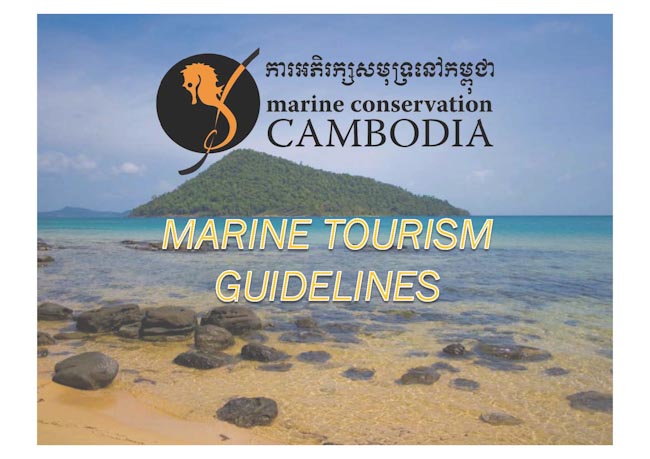
After receiving feedback on your end of internship presentation, you can then use this as preparation for a presentation at your own university or other academic institution. This not only assists in developing your communication skills, it relays the findings of your time in Cambodia to your peers and displays your commitment and research skills, this in turn helps us to reach a wider audience and gather attention to Cambodia’s needs from more than just the local scientific community, this has the potential to attract more interest and make a substantial difference to our work saving Cambodia’s unique and diverse marine habitats.
Written Report of your findings:
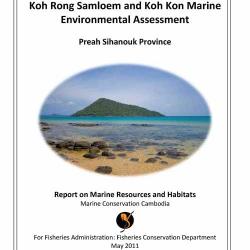
If your work is of outstanding quality and addresses an issue relative to Cambodia’s Marine Environments it will be passed on to the Cambodian Department of Fisheries Conservation and if published in their yearly fisheries publication, we will offer you a 1 month free stay back at our project site. (your report will also be published on our website)
Publish your work in a peer-reviewed publication:
If you are able to publish your final report in a peer-reviewed journal, we will offer you the opportunity to return for as long as you need to carry on your research at a heavily discounted cost. We will also assist you in financing your continued research work in Cambodia.
Future work opportunities with Marine Conservation Cambodia.
During your time with us we will be assessing your potential to become a permanent member of our team, if your work is outstanding and directly contributes to the goals of the project we will offer you a full time position within the team and assist you in funding your continued academic work in Cambodia.
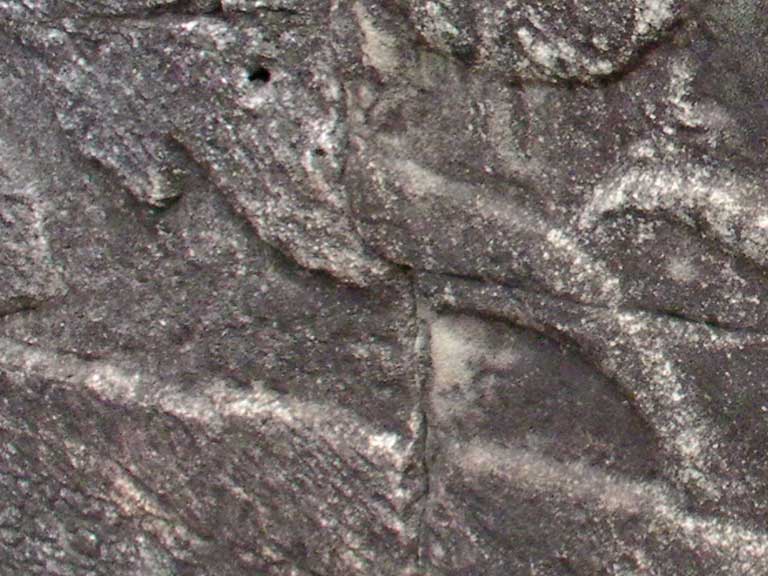
 So here we are volunteering to research Seahorses.
So here we are volunteering to research Seahorses.
These little creatures are the reason MCC was originally created, watching them, photographing them, getting to know every individual that we dived with, and then the trawlers started!! first one site, then another until almost all of our diving sites were devastated and destroyed, Instead of our daily visits it could take weeks just to find one individual.
So we started to fight back and that is how MCC began, and now 8 years later we are not only researching but also fighting for these little guys and also every ecosystem left that is under threat from illegal trawling boats, dragging their nets indiscriminately across the bottom of the ocean devastating everything they pass over. But its not all doom and gloom, our work is paying of and now we have secured areas that we can research and where we can return daily to see and document the lives of these amazing creatures.
You can read more about MCC’s Seahorse research in National Geographic and on the Project Seahorse Website.
Below are a few interesting seahorse facts and a little background on Seahorses in Cambodia.
The Seahorse itself is a wonderful creature that has for centuries been believed to hold magical and medicinal qualities (these myths have led to Seahorse populations around the world being targeted). A seahorse has a horse-like head, bony plated body and prehensile tail. Today, there are about 32 known species of Seahorses. Seahorses make up the genus Hippocampus, which is from the family Syngnathidae, which otherwise contains Pipefish, Pipehorses and Seadragons.
To date Marine Conservation Cambodia has identified and photo documented 5 Confirmed species of Seahorse with 3 more species suspected by both MCC and Project Seahorse of being in Cambodian Waters. There is also a definite possibility of other species or even sub species that have yet to be positively identified. You can see a selection of our previous Seahorse Reports here, for our current research and documents please contact us.
Confirmed
Suspected
 Most Seahorses in Cambodia are found in coastal waters, typically at depths of 1-30 meters, occurring in relatively sheltered environments among sea-grasses, kelp beds, rocky reefs, mangroves, Sandy bottoms and coral reefs. Unfortunately these are some of the most vulnerable of Cambodia’s marine environments, highly susceptible to disturbance caused by human activities.
Most Seahorses in Cambodia are found in coastal waters, typically at depths of 1-30 meters, occurring in relatively sheltered environments among sea-grasses, kelp beds, rocky reefs, mangroves, Sandy bottoms and coral reefs. Unfortunately these are some of the most vulnerable of Cambodia’s marine environments, highly susceptible to disturbance caused by human activities.
Many life history and biological factors enhance Seahorses vulnerability to disturbance and exploitation and reduce their potential for recruitment and recovery. These factors include: low mobility, limited home ranges and high site fidelity, low fecundity, live brooding and lengthy paternal care, mate fidelity and late maturity.
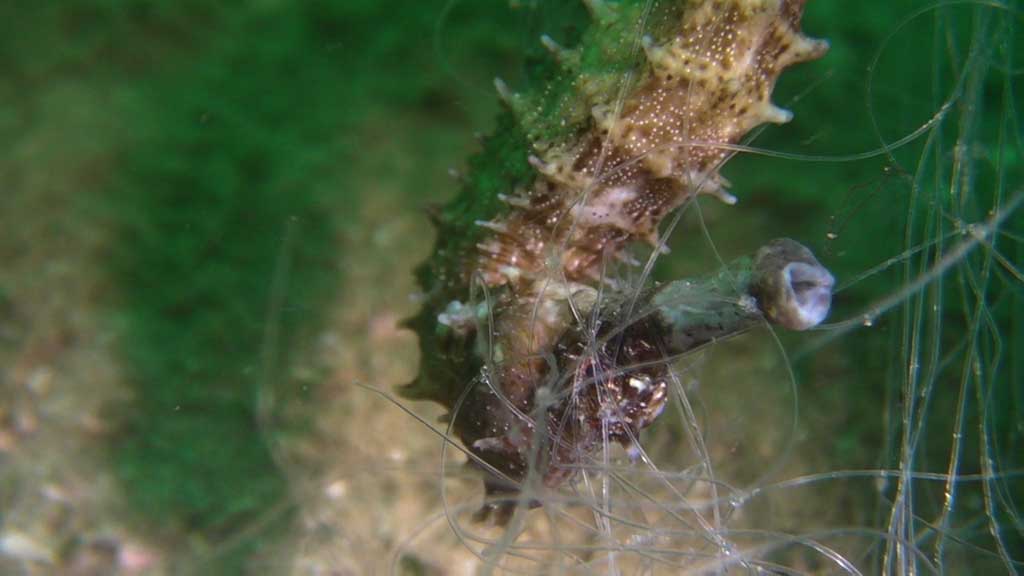
Conservation and protection of seahorses requires an understanding of the biology and behaviour of the animals and the threats that they face. Since early 2006 we have been observing the increased threats to these creatures in Cambodian coastal waters. Seahorses where an abundant species in Cambodia. Up to 7 species have been identified so far at both sandy sea bed areas and sea grass meadows near Sihanoukville and Kampot but the numbers have dropped dramatically and some species have not been seen at all during the past 12 months. To protect these beautiful and secretive creatures of the sea we perform extensive research on their populations densitys, their biology and their behaviour. We have managed to secure two of the main breeding grounds and are currently working on the physical protection of these species as they are highly vulnerable to illegal and destructive fishing techniques especially weighted bottom trawling. Demarcation of these areas through deployment of physical barriers is one of many ways to realize protection. The creation of community patrolled areas is another, with the help of the community on Koh Rong Samloem, local authoritys and the fisheries administration we have come along way in stopping the decline of these beautiful creatures.
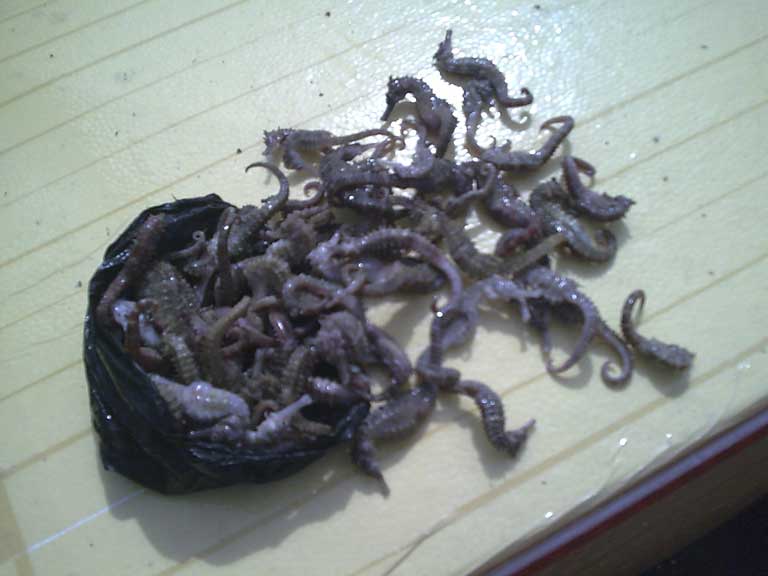
Many Syngnathids are listed as threatened on national and international criteria. Seahorses are listed in the United Nations Environment Programme-World Conservation Monitoring Centre (UNEP-WCMC) Animals of the World Database and are included on the International Union for the Conservation of Nature and Natural Resources (IUCN) 2000 Red List. Seahorses are included in the Cambodian list of endangered and protected species however this list is not 100% adopted yet.
The international trade in seahorses Hippocampus spp for traditional medicines, aquarium pets, and curios is a huge, valuable and seemingly unsustainable. The majority of landed seahorses are sold on to be used in traditional Asian medicine’s. Traditional Chinese Medicine is recognized by the World Health Organization as a viable health care option, and has a global constituency. Seahorses are used to treat a range of conditions, including respiratory disorders such as asthma, impotence and other sexual dysfunctions, and general lethargy and pain.
Many different nations and territories around the world are involved in buying and selling seahorses, from Ecuador to Italy to Mozambique to the U.S.A. The largest known net importers are China, Hong Kong, and Taiwan. The largest known exporters are Thailand, Vietnam, India, and the Philippines. Most of Cambodia’s illegal trade in Seahorses goes through the beach market in Kep and is directly transported to Vietnam the current price per kilo according to local sources is 500 us dollers per dried.
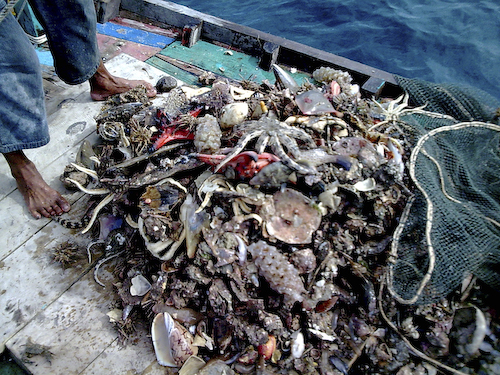
In Cambodia the combination of directly targeted catch and the huge incidental by-catch in weighted bottom trawling nets coupled with the destruction of large areas of seahorse Habitat has placed Cambodia’s once plentiful Seahorses at serious risk. Conservation and management plans are urgently required. The new community conservation areas around Koh Rong Samleom, Koh Rong and Kep play an important role in the conservation of Cambodia’s vulnerable Seahorse populations. These new conservation areas will if well policed help to address the issues of habitat loss and also direct catch and by-catch by offering a haven for these dwindling populations.
Extensive habitat loss resulting from human activities such as coastal developments and destructive fishing techniques, dredging, infilling and removal of mangroves and seagrasses, has managed to fragment Seahorse populations and may have resulted in localized extinctions as some species once frequently encountered have not been seen for many months.

The commercial trade in Seahorses, from target fisheries and by-catch fisheries, is currently thought by many different organisations to be the major threat to Seahorse conservation worldwide.
Seahorses were the main focus when we started Marine Conservation Cambodia, our team has now been working on securing the saftey of Cambodia’s seahorses since 2007. We have managed to stop most illegal collections of seahorses around the Islands of Koh Rong and Koh Rong Samleom, and we are now actively involved in stopping the illegal and destructive fishing within Kep province that is destroying the local seahorse populations and critical habitats, here are some of the ways that together with our volunteers and interns we are achieving this.
 Assist fishing communities, through education and training, developing the skills and legalauthority they need to manage their local resources.
Assist fishing communities, through education and training, developing the skills and legalauthority they need to manage their local resources.Biology of seahorses
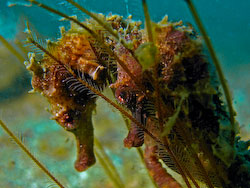 Seahorse biology causes most species to be particularly susceptible to over-fishing:
Seahorse biology causes most species to be particularly susceptible to over-fishing:
These problems are being investigated by acquiring comprehensive knowledge of Seahorse biology and behaviour within the species found in Cambodian waters. As much information as possible is being collected on areas such as growth rates, longevity, juvenile dispersal mating habits and general habitats to be able to create a comprehensive protection/conservation program.
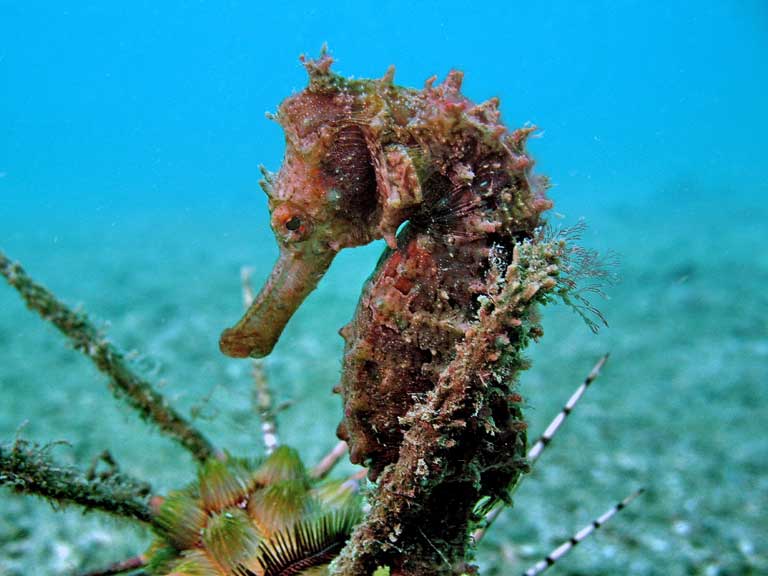
Seahorses have heads at right angles to the body and fully prehensile tails, which wrap around sea-grass stems, corals, sticks, or any other suitable natural or artificial object. These traits, along with a pouch for the young and eyes that swivel independently of each other, lend to the unique nature of these fish. Instead of the scales found on most fish, seahorses have a thin layer of skin stretched over a series of bony plates visible as rings around the trunk. These rings are useful in identifying species, as are the cheek spines and coronet (a crown-like group of spines on the top of the head). In addition to the spines, some species also have bony bumps or skin filaments protruding from these bony rings.
Like other fish, they breathe through gills, extracting oxygen from the water that passes over them. Unlike other fish, however, the gills are small and compacted, almost grape-like in structure. Seahorses swim using the propulsive force of a quickly oscillating dorsal fin, and use the pectoral fins on either side of the body for steering and stability.
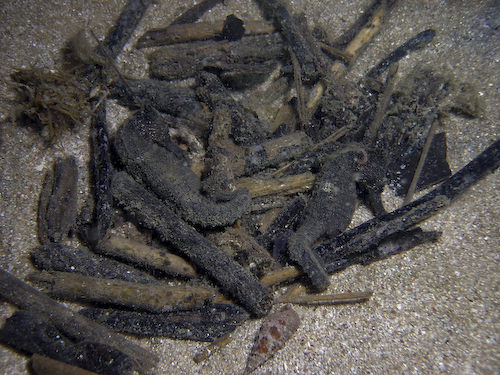
Seahorses are masters of camouflage, changing colour and growing skin filaments to blend in with their surroundings. They are more adapted to maneuverability than speed, and therefore rely primarily on camouflage to avoid detection from predators. Short-term colour changes may also occur during courtship displays and daily greetings. Male and female seahorses can be told apart by the presence of a brood pouch on the male.
Seahorses have no stomach or teeth. They suck in prey through a tubular snout and pass it through an inefficient digestive system. Seahorses are voracious predators, relying entirely on live, moving food. They will sit for prey to come close enough and then sucking them rapidly from the water with their long snouts. Their eyes move independently of each other, maximizing their search areas. They will ingest anything that is small enough to fit into their mouths mostly small crustacea such as amphipods, but also fish fry and other invertebrates.
Reproduction and Lifespan
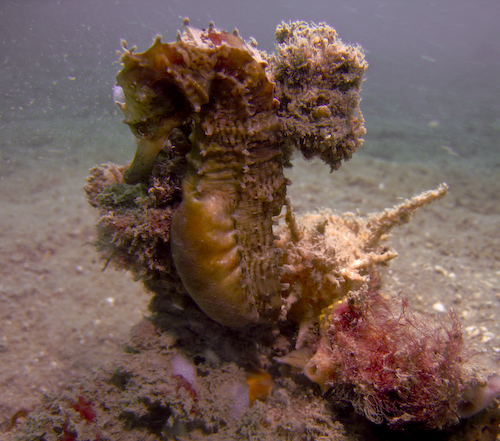
The male seahorse, rather than the female, becomes pregnant. This unusual mode of reproduction is the most extreme form of male parental care yet discovered. Natural lifespans for seahorses are virtually unknown. Most estimates come from laboratory or aquarium observations. Known lifespans for seahorse species range from about one year in the smaller species to an average of three to five years for the larger species.
Sexual maturity in males is usually determined by the presence of a brood pouch. Male seahorses are able to become pregnant any time during the breeding season, which varies with species, and is most likely dependant on temperature of the water. Other factors that may affect the timing of the breeding season are monsoon patterns and the lunar cycle.
Most species of seahorses are monogamous, forming pair bonds that last the entire breeding season (and perhaps even last over several breeding seasons), although some species may not be pair-bonded. Pair bonds are reinforced by daily greetings in which the female and male change colour and promenade and pirouette together. This dance lasts several minutes, and then they separate for the rest of the day. The greetings occur throughout the male pregnancy, and are even thought to ensure that the male and female are ready to re-mate at the same time. Once the male has given birth and it is time to re-mate, sometimes only hours later, this greeting is extended into a courtship that, for one species, lasts up to nine hours.
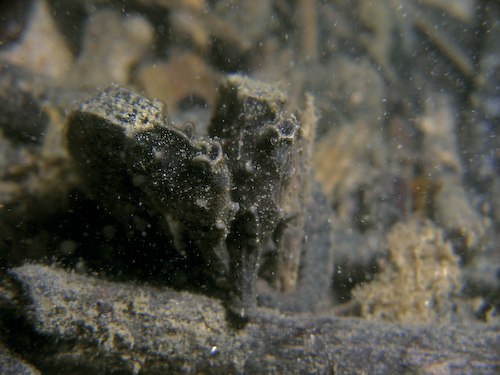
The female inserts her ovipositor into the males brood pouch, where she deposits her eggs, which the male fertilizes. The fertilized eggs then embed in the pouch wall and become enveloped with tissues. The pouch acts like the womb of a female mammal, complete with a placental fluid that bathes the eggs, and provides nutrients and oxygen to the developing embryos while removing waste products. The pouch fluid is altered during pregnancy from being similar to body fluids to being more like the surrounding seawater. This helps reduce the stress of the offspring at birth.
 Pregnancy lasts between two and four weeks, the length decreasing with increasing temperature. At the end of gestation the male goes into labour (usually at night), pumping and thrusting for hours to release his brood. Young are miniature adult seahorses, independent from birth, and receive no further parental care. Newborns of most species measure 7-12 mm. The number of young released averages about 100-200 for most species, but can be a low as five for the smaller species, or as high as 1,500.
Pregnancy lasts between two and four weeks, the length decreasing with increasing temperature. At the end of gestation the male goes into labour (usually at night), pumping and thrusting for hours to release his brood. Young are miniature adult seahorses, independent from birth, and receive no further parental care. Newborns of most species measure 7-12 mm. The number of young released averages about 100-200 for most species, but can be a low as five for the smaller species, or as high as 1,500.